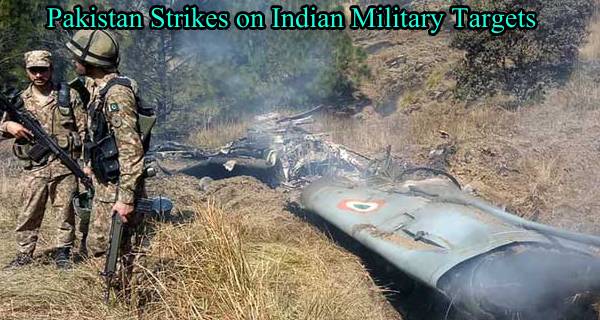Pakistan claims it has carried out retaliatory strikes on multiple Indian military targets, including airfields and missile sites, amid escalating tensions over Kashmir. Discover the full list of targets and what this means for regional security Pakistan Targets Indian
In a major escalation of tensions between two nuclear-armed neighbors, Pakistan’s military has claimed it carried out precision strikes against multiple Indian military installations, including locations within India-administered Kashmir and deep inside undisputed Indian territory. This move, described by Islamabad as a “proportional and calibrated response”, comes in the wake of alleged Indian missile strikes on Pakistani soil.
Table of Contents
Overview of Pakistan’s Claimed Military Action
According to a statement from the Inter-Services Public Relations (ISPR)—the media wing of the Pakistan Armed Forces—the Pakistani military targeted key Indian defense infrastructure in a retaliatory operation. These sites are reportedly linked to the Indian air strikes that Pakistan claims struck parts of its territory.
The List of Claimed Pakistan Targets Indian
Pakistan’s military specifically mentioned the following Indian military assets as being hit:
- Brigade Headquarters at KG Top
- Field Supply Depot in Uri
- Artillery Gun Position at Derangyari
- BrahMos Missile Battery Site in Nagrota
- Udhampur Airfield
- Pathankot Airfield in Punjab, India
- Suratgarh Airfield in Rajasthan, India
These sites are situated both within the disputed region of Jammu and Kashmir and well into India’s internationally recognized territory. Notably, the inclusion of airfields such as Pathankot and Suratgarh indicates a widening of the military confrontation beyond traditional flashpoints.

Strategic Significance of the Targets
Each of the locations Pakistan claims to have targeted holds strategic military value:
- KG Top and Uri are located along the Line of Control (LoC) and serve as key logistical and command nodes for Indian forces.
- Derangyari, reportedly hosting artillery units, plays a role in India’s forward defense posture in Kashmir.
- Nagrota is home to an important Indian Army base and a BrahMos missile unit, which represents a significant deterrent and strike capability.
- Udhampur is the headquarters of the Indian Army’s Northern Command and a crucial logistics hub.
- Pathankot, infamously targeted in a 2016 militant attack, houses air force and army units.
- Suratgarh, located in western Rajasthan, is a critical airbase near the Indo-Pak border.
A Response to Alleged Indian Aggression
The Pakistani military described the action as part of its “right to self-defense”, stating that these sites were selected based on their involvement in recent Indian missile operations against Pakistan. While CNN and other international media outlets have not independently verified these claims, Pakistan maintains that it acted only after being provoked.
In a televised statement, Major General Ahmed Sharif Chaudhry, Director-General of ISPR, noted:
“This was a necessary response to India’s unprovoked aggression. We have struck only military targets to avoid civilian casualties and to convey a clear message: Pakistan will respond decisively to any violation of its sovereignty.”
India Yet to Respond Officially:Pakistan Targets Indian
As of this writing, the Indian Ministry of Defence and the Indian Air Force have not issued an official response to Pakistan’s claims. However, defense analysts in India have expressed skepticism about the scale and accuracy of the reported Pakistani strikes.
India’s official narrative has so far focused on its counter-terrorism efforts, particularly in the Jammu and Kashmir region, where tensions have been heightened due to insurgent activity. New Delhi has repeatedly accused Pakistan of supporting cross-border terrorism, an allegation Islamabad denies.
Growing Regional Tensions
The reported strikes are part of a broader deterioration in India-Pakistan relations, especially concerning the disputed Kashmir region, which both nations claim in full but govern in parts.
In recent weeks, cross-border shelling, aerial patrols, and military build-ups along the LoC have surged, fueling fears of a wider conflict. These developments have alarmed international observers and prompted calls for restraint from major global powers including the United States, China, the United Nations, and the European Union.
Possible Implications
Experts warn that continued military escalation between India and Pakistan could have far-reaching consequences:
- Civilians living along the border face renewed displacement and danger.
- Bilateral trade and diplomatic channels, already minimal, risk complete breakdown.
- The South Asian security environment, already volatile, could spiral into a larger conflict with global ramifications.
Dr. Ayesha Jalal, a South Asia analyst based in Boston, commented:
“Both India and Pakistan are engaging in a dangerous game. Any miscalculation could lead to a conflict that neither side can afford, especially given their nuclear capabilities.”
Global Reactions and Calls for Pakistan Targets Indian
In response to the escalating situation, the United Nations Secretary-General has urged both countries to de-escalate and engage in dialogue. Similarly, the U.S. State Department has released a statement emphasizing the need for both nations to avoid military confrontation and resolve issues through diplomatic channels.
Media Coverage and Verification Challenges
Due to restricted media access to the Line of Control and the use of military-grade misinformation by both sides, independent verification of events remains difficult. Both Indian and Pakistani media often reflect national perspectives, complicating objective reporting.
CNN and other international news agencies have reported that they are awaiting official confirmation or response from Indian defense authorities.
Conclusion: Pakistan Targets Indian
Pakistan Targets Indian Pakistan’s claims of striking Indian military targets mark a serious escalation in South Asia’s already tense security situation. While Islamabad frames its actions as retaliatory and proportionate, the potential for further military exchange remains high.
As the region teeters on the brink of greater conflict, the international community continues to urge calm, de-escalation, and a return to dialogue. The coming days will be critical in determining whether this confrontation will evolve into a prolonged standoff or whether both sides can find an off-ramp through diplomacy.